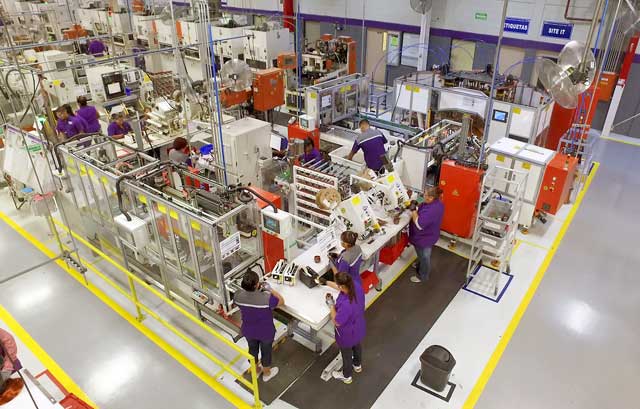 As a company grows, changing processes become increasingly deliberate, systematic and slow. But where the safety of workers is concerned, changes need to happen quickly. In the face of a known risk, there is no time to analyse, deliberate or weigh options. Any safety risk – large or small, anywhere, at any time – must be immediately addressed and resolved, regardless of complexity or cost.
As a company grows, changing processes become increasingly deliberate, systematic and slow. But where the safety of workers is concerned, changes need to happen quickly. In the face of a known risk, there is no time to analyse, deliberate or weigh options. Any safety risk – large or small, anywhere, at any time – must be immediately addressed and resolved, regardless of complexity or cost.
Not all manufacturing companies are structured to move this quickly. But, as Pat Robinson, Vice President for Environmental Health, Safety and Sustainability at Regal Beloit Corporation explains, there is a process that can drive urgent change. What Six Sigma is to lean manufacturing, the Japanese concept of kaizen is to best practices in safety.
The word kaizen simply means “change for the better.” In practice, it means creating a culture of continuous improvements throughout a company, from the chief executive to the newly-hired assembly line worker. The kaizen process slices through organisational boundaries and standard approval processes to allow immediate changes to eliminate safety risks.
In a kaizen culture, whenever an employee – any employee – identifies a safety risk, devising a solution as quickly as possible becomes a corporate priority: no employee should be allowed to remain at risk. If the same problem exists elsewhere in the company, the change is implemented company-wide as a safety best practice. One company may make hundreds of kaizen improvements in any given year, from changing the model of a hammer to a complete rebuild of an assembly facility.
To an outsider, the imperative to immediately eliminate risks may look like the corporation is simply throwing money at its problems. The fact is, when kaizen is embraced as a corporate best practice, its culture of continuous improvement results in significantly lower employee absenteeism, higher productivity and greater regulatory compliance.
For Regal Beloit Corporation, kaizen is a global culture of safety. As a leading manufacturer of electric motors, electrical motion controls, power generation and power transmission products, with 23,000 employees located at facilities throughout the United States, Canada, Mexico, Europe, Asia and Australia, Regal makes sure every employee in every country is thoroughly trained in the kaizen approach to safety.
Before Regal adopted kaizen, safety processes were largely the responsibility of a safety or human resources manager who made scheduled inspections, and updated the “x Days Between Accidents” signs frequently seen at manufacturing centres. As Regal learned the principles of kaizen, the company realised its process was upside-down.
Who has the better eye for detail at a workstation: the safety manager, or the employee who is getting stung by sparks while welding stator cores? Regal had to empower that employee to take the responsibility of reporting the problem on the safety board located in every facility, knowing that even the tiniest issue will be fixed quickly.
When a shipping employee in Monterrey, Mexico, saw a co-worker working on her knees and leaning backward to position a box, he posted a card on the “Near Miss” bulletin board, visible to all employees. Regal responded by ordering and installing a conveyor belt for the shipping department.
For individual employees, the key kaizen principle is to take care of each other. Use your eyes. The company wants workers to report any risk, no matter how small. Even more importantly, it wants them to see that the company made the change – quickly. They see the difference. But it doesn’t just happen. Kaizen requires building a corporate safety structure around it – and everyone is responsible for each other.
Senior leaders are on the floor every day, helping to drive rapid changes – often major changes – showing employees their determination to create a zero-harm environment and keep everyone absolutely safe.
Not infrequently, this can call for major action and investment. In Erwin, Tennessee, an employee sent a smartphone photo to a safety manager, to show that the entire assembly area was cluttered and dimly lit. Subsequently, the lighting system there was completely changed, and a new layout of the space was designed to eliminate clutter and congestion. During a gemba walk in Changzhou, China, managers realised that the facility was uncomfortably warm. A $300,000 HVAC system was immediately approved and installed.
The idea of kaizen is continuous improvement. In just the first half of 2017, Regal has taken hundreds of actions to resolve safety issues, and identified 21 safety best practices to be applied in all facilities. Regal’s injury rate and lost hours are down from last year, and keep going down year after year, while overall productivity continuously improves. The company believes the kaizen culture goes beyond safety. Employees know they’re heard, and when they have an idea to improve a process or productivity, they can speak up with confidence that, through kaizen, action will follow. In this way, each employee contributes to overall performance and excellence.

